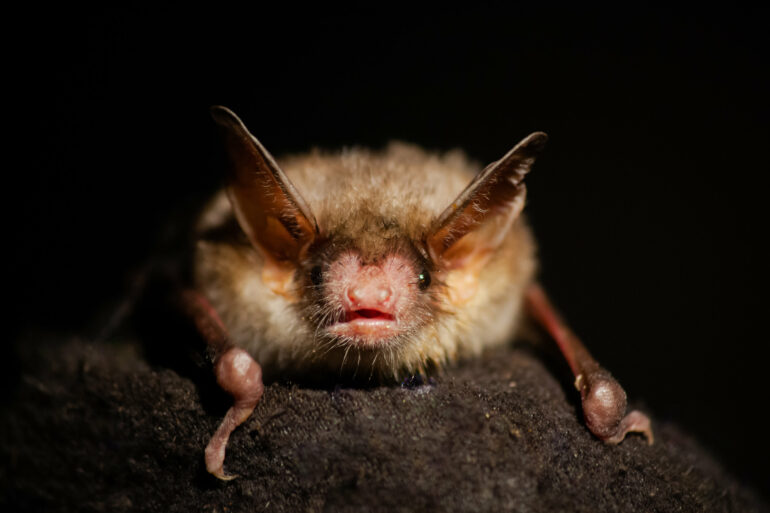Foraging greater mouse-eared bats invest more resources in hunting large, difficult-to-catch, ground-dwelling insects over smaller, more easily caught flying insects, despite a greater risk of failure.
These findings, published today in eLife, demonstrate that these bats primarily deploy high-risk, high-reward tactics of hunting more nutritious ground-dwelling insects, but switch to hunting airborne insects when environmental conditions hinder the viability of hunting ground prey.
The study helps us understand how these small predators reach their daily energetic requirements and may inform protection strategies for bat populations against future environmental changes caused by human activity.
Previous research on predator-prey interactions has focused mainly on the hunting strategies of large predators. Much less is known about smaller, more abundant predators, despite the crucial role they play in ecosystems across the globe.
An example of a small, highly specialized predator is the bat. Their unique combination of being the only mammal with powered flight and using echolocation to sense in darkness allows them to fill a specific ecological niche, hunting at night to reduce competition from rival predators such as birds. Their small size and high metabolic rate, due to powered flight, means that they require a high and constant input of energy from their food.
“Bats are widespread and common predators that are crucial for many ecosystems around the world, but their species and numbers are in decline,” says lead author Laura Stidsholt, a Villum International postdoc at Leibniz Institute for Zoo and Wildlife Research, Berlin, Germany. “Therefore, understanding how bats adapt their foraging strategies in changing environments is crucial for predicting their responses to future ecological changes.”
Stidsholt and colleagues investigated the foraging tactics of the greater mouse-eared bat, which captures prey through two main strategies: targeting small insects in the dark sky, and scouring the ground for large insects. Due to the complexity of studying detailed hunting behaviors in the wild, it is not clear what determines the choice of hunting ground or aerial prey in bats.
In order to address this gap, the team attached miniaturized backpacks with a microphone to 34 greater mouse-eared bats. This allowed them to record the bats’ echolocation behavior, movement patterns, GPS location and chewing sounds—which the team used to determine a successful hunt. They noticed that the dominant foraging tactic was mostly uniform across the bats on a given night, suggesting that each bat adapts its strategy to environmental conditions such as rainy or windy weather.
The team recorded a total of 3,917 attacks on prey, with each bat catching an average of 25 aerial insects and 29 ground insects each night, suggesting their reliance on both food sources. The bats targeted prey on the ground more frequently, at an average of 80 attacks per night, compared to 36 aerial attacks. Attacks on ground targets were over twice as likely to be unsuccessful, raising the question of why bats invest their limited energy into a riskier tactic.
To answer this, the team estimated the profitability of airborne and ground prey by dividing their estimated caloric values by the time it took the bats to search for and handle the prey, accounting for the success ratios of each strategy. DNA analysis of the bats’ feces allowed the team to estimate the sizes of prey consumed. They found that insects caught from the ground were between 3–20 times heavier than aerial prey. Because of this larger size and greater nutritional value, ground prey profitability was up to 14 times higher than aerial prey, even when accounting for the higher rate of failure. In fact, around 85% of the energy intake from a night of foraging came from ground targets, despite the similar number of aerial insects consumed.
The bats typically managed to forage enough to reach their predicted energy requirements across the course of a night, but only just so. This suggest that they may be struggling to gain enough reserves to survive the winter, or to fulfill their caloric requirements when environments change.
“We show that prey-switching behavior according to environmental changes plays a key role in covering the energy requirements of specialized predators like bats,” concludes senior author Peter Madsen, Professor of Zoophysiology in the Department of Biology, Aarhus University.
“Since most bats fly out just after sunset and return in the early morning, they are particularly vulnerable to any disturbance or change in habitat quality that may reduce their foraging intake—which has worrying implications for future bat populations as human activity continues to affect the natural environment.”
More information:
Laura Stidsholt et al, Echolocating bats prefer a high risk-high gain foraging strategy to increase prey profitability, eLife (2023). DOI: 10.7554/eLife.84190
Citation:
Bats’ high-risk, high-gain hunting tactics increase prey profitability (2023, April 18)



